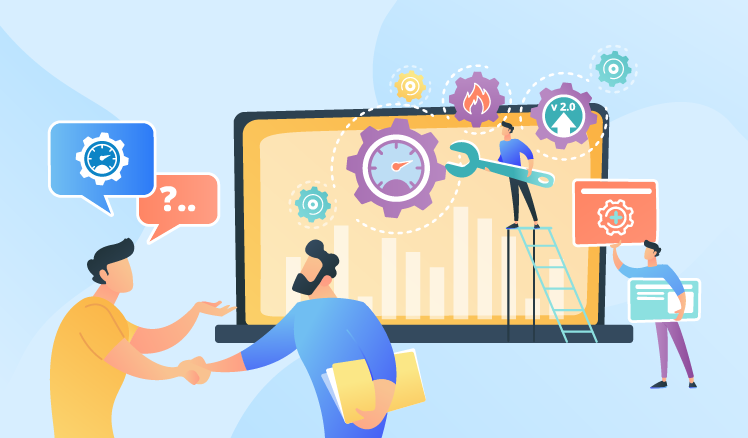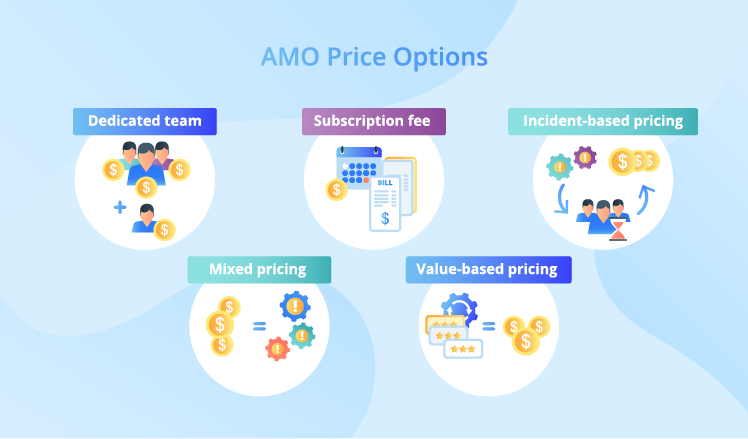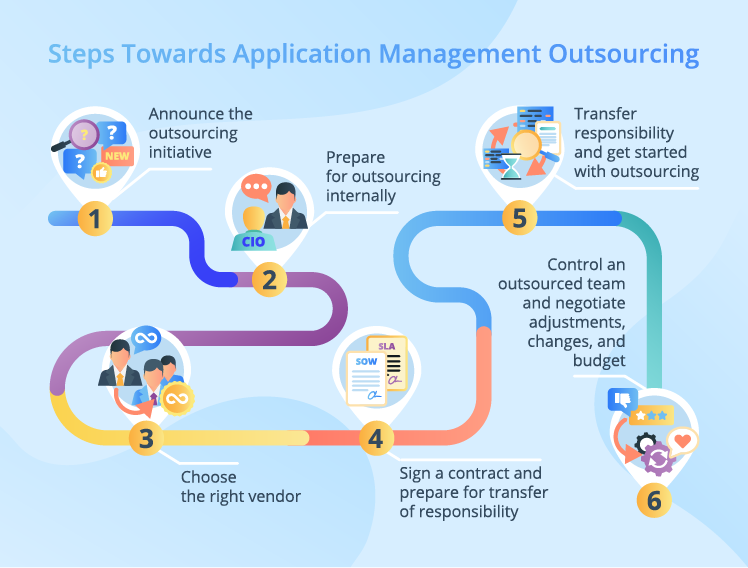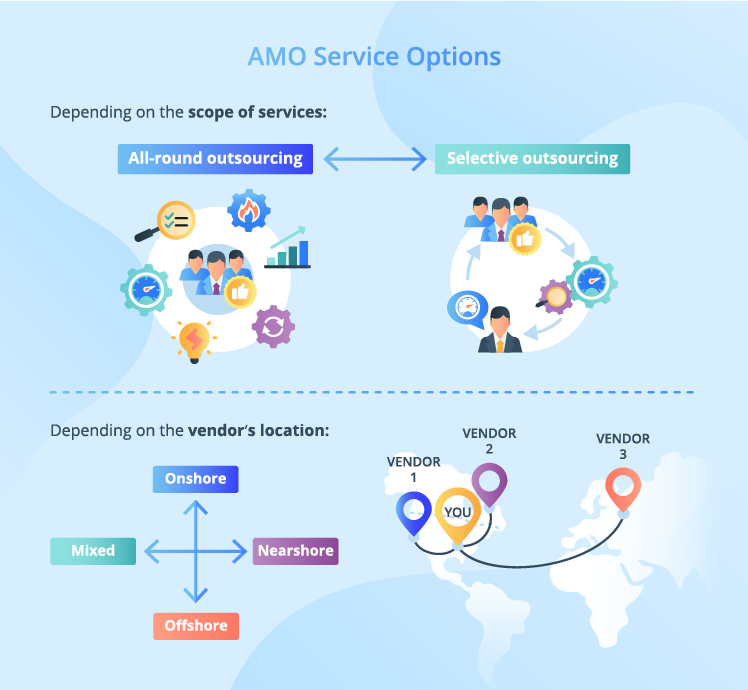How to Outsource Application Management and Not Get Disappointed
According to Statista, application management is currently one of the IT functions most attractive for outsourcing. It is also expected to further grow and develop in the next 5 years. The main reason for this is the possibility to significantly reduce the cost of application management while improving its quality.
In this post, we’ll reveal the important attributes of successful application management outsourcing (AMO), discuss what service and payment options businesses have today and what additional benefits they can expect.

What application management can include
Application management services comprise a wide range of activities aimed at ensuring an application’s health (availability and high performance) and relevance to current business needs. The application management may include:
- Proactive monitoring and troubleshooting.
- Performance management.
- Incident management.
- Enhancement management and evolution.
- Help desk services, and more.
Application management outsourcing is more than specialized expertise and saved money
Today, outsourcing is driven by much more than reduced costs and scarce skills:
- It’s easier to scale the outsourced team up and down in case the project scope increases or project pipeline extends.
- Ongoing access to a wide range of technologies, methodologies and processes.
- Improving the quality of service (software availability, user experience, etc.).
- The in-house IT department can devote more time to the strategic development of the company’s IT environment.
Application management outsourcing comes in different forms
The options for application management outsourcing are diverse. Depending on the scope of services, we can speak about:
- All-round outsourcing, which means that the vendor assumes responsibility for the complete management of activities around application support, enhancement, and optimization. The vendor not only provides tech services but also offers ideas and recommendations on beneficial optimization and evolution of the application according to new business requirements and helps to enable, structure and implement the right digital transformation initiatives.
- Selective outsourcing, which means delegating to the vendor responsibility for a certain aspect of application management (be it application troubleshooting or enhancement) or a specific set of aspects (performance management and monitoring, troubleshooting and application enhancement).
Also, depending on the vendor’s location, AMO can be:
- Onshore – the vendor is placed in your country.
- Nearshore – the vendor is placed in a neighboring country or at least within your time zone.
- Offshore – the vendor is placed in a different time zone or continent.
- Mixed – for example, having customer operations onshore and the technical team placed offshore.
The nearshore and offshore options are often considered more cost-effective. But such cooperation can be vulnerable to communication problems, time zone differences, a language and a cultural gap as well as imply legal issues.
Application management outsourcing entails different pricing models
The modern market of AMO is well-developed and offers a wide range of pricing models.

You can opt for engaging a dedicated team for application management and pay monthly an established sum to an AMO provider depending on the number of people you attract to this team.
Another option is that an AMO provider can bill you at a fixed price on a monthly or annual basis. A subscription fee allows you to feel confident about the IT budget as you can predict future spending quite precisely. However, if your system is not demanding in terms of management, you can end up with considerable overpaying.
When you know that the average number of issues is usually low, incident-based pricing can work well for you. In this case, your payment bases on the amount of time a service vendor’s team spends on a task and its complexity. The challenge of such an approach consists in the proper evaluation of efforts that are required for problem resolution. You’ll have either to trust the vendor or to control the estimation process.
Mixed pricing is probably the universal solution in the AMO sphere. You pay a basic fee and get a restricted available number of issues to be solved. All ‘overdraft’ requests or more complex cases are charged individually.
Value-based pricing is a relatively new approach to pricing but with a good tendency to become popular. This pricing type depends on the real beneficial outcomes of the service. For example, in the case of proactive monitoring activities, the outcome should be a definite decrease in the number of registered requests. With this pricing model, you considerably lower the risk of insufficient quality and not the fully covered scope of the service. The challenge of this model lies in the definition of clear, traceable and mutually agreed SLOs and KPIs.
Steps Towards Application Management Outsourcing
Let’s explore your actions in case you consider taking advantage of AMO.

You announce the outsourcing initiative.
This stage is all about asking the right questions. Will it be total or selective outsourcing? What exactly you aim to achieve – bring innovations, improve quality, better address your customer’s needs, etc.' How serious the security risks are? How to make it cost-effective?
You also analyze the current state of the applications and systems you plan to outsource. To reduce future management costs for legacy applications and simplify maintenance, you can include in your outsourcing contract step-by-step application modernization, including such improvements as application migration to modern languages and frameworks, and application re-engineering.
You prepare for outsourcing internally.
Taking into account the size, age, complexity, workload, and criticality for the business of the apps the management of which you want to outsource, decide on the form of outsourcing you need and the key goals you expect to achieve. A designated person (CIO, operations manager, management of related non-IT department, etc.) should supervise the process on your side. They should not only possess sufficient tech skills but essential vendor management skills as they need to closely monitor SLA and budget execution by an outsourcing service provider, analyze the provider’s reports and coordinate application needs with the company’s changing business requirements.
You choose the right vendor.
We can enumerate at least 5 universal points for you to consider while looking for the right service provider:
- Flexibility in terms of cooperation. A good outsourcing company should be able to deliver exactly as much as you need, without offering unnecessary services, as well as further scale the team and services up and down according to your needs.
- Modern approaches. If you have a positive experience with the benefits of the DevOps practices (including automated testing, automated infrastructure, Continuous Integration (CI) and Continuous Delivery (CD)), serverless computing, and hybrid cloud architecture, or want to implement some, make sure a vendor can support your app operations with these new approaches.
- Continuous and organized communication. The communication with your vendor should be structured and multilevel. Make sure the vendor can assign several managers on several levels – your C-suite, manager of the outsourcing project, project owner, application stakeholders from your IT and non-IT departments and in-house BA, QA experts, team leads – who’ll be responsible for all communication with you and your people at each level. A vendor should be available via your preferred channel, be it email, instant messages, phone, specific ITSM tools like Jira, Zendesk, SolarWinds, BMC Helix, and ServiceNow, or – for external users – also CRM systems like Salesforce and Zoho.
- Global reach. First, time zone differences can become a serious problem. To ensure immediate assistance, get a vendor who can adapt to round-the-clock support across various locations. Second, knowledge of languages and understanding the local specificity is important for the support of external users, as well as other vendors and partners.
- Proved ability to comply with quality standards and regulations. A service provider should have established practices of quality control, comprehensive QA, and compliance with quality standards like HITECH, FDA policies, ISO 13485, and ISO 27799:2016. In highly regulated industries, such as banking or healthcare, it is one of the main checkpoints to successful cooperation.
When choosing an application management vendor, you’ll probably rely on the overall description and experience of the company. Yet, you never know whether the best or the worst of their employees will manage your applications. Take time to interview the people who’ll work on your project to assess their tech and soft skills, make sure they can quickly understand what and how you expect them to do. In the case of offshore outsourcing, check sufficient language proficiency and absence of a cultural barrier to avoid communication problems with the outsourced team.
It’s also important to establish a strict security policy, check if the vendor has experience with sensitive data, and review their practices of dealing with security challenges. Make sure that in your company, in turn, there are established verification processes of direct and indirect access to corporate applications. Thus, you’ll avoid cases when your AMO provider gives access rights to the employees not entitled to them.
You may also choose a multi-vendor policy. It is especially relevant for large enterprises that outsource heterogeneous applications. Multiple outsourcing allows for reaching wider tech options, avoiding vendor lock-in, reducing pricing risks and taking advantage of a particular vendor specialization.
You sign a contract and prepare for the transfer of responsibility.
At this stage, you’re to draw up and sign two important documents – SOW (Statement of Work) and SLA (Service Level Agreement) to protect yourself from either insufficient service or, in contrast, excessive services, and associated additional expenses.
In the documents, you need to develop clear definitions and a common understanding of the outsourcing process and its future progress. Specify the scope of the services you expect to get and their time frames. Define the metrics to quantify the service success and describe the way you’re going to track the service progress. The KPIs can include a definite application response time and a certain decrease in the number of registered incidents (for proactive troubleshooting). Establish the amount of time for incidents to be handled and decide how problem escalation and incident prioritization will happen, how and when the incidents will be closed.
You transfer responsibility and get started with outsourcing.
A switch to a new service model doesn’t happen overnight. A service provider’s team will need time to study underlying IT infrastructure, code documentation, application requirements, and test results as well as learn the embedded application management processes and routines to start work. So, you should ensure the availability of up-to-date code and test documentation, technical specifications and business requirements. In case of their scarcity, let a vendor mine knowledge from code and application behavior as well as motivate employees in the know to share the application-related information they have. Thus, from 3-week to 6-month time (depending on the system complexity) will be attributed to knowledge transfer and a deep technical dive of an outsourced team in general. Furthermore, while ‘routine’ outcomes will come right away, the ‘real management’ – when the team is fully capable and independent in service provision as well as can provide valuable insights on optimization or transformation of existing processes – may start only in about a year.
During this stage, you need to make sure that the outsourced application management team is easily reachable via all agreed means of communication, your employees and external users know how and where they can place their tickets and whom to contact in case of need.
As finding the right recipe of your application management can take some time and flexibility on both sides, running a service trial period can be a good idea. If the amendments to the service plan are required, get back to the previous stage and negotiate the terms of SOW and SLA documentation with new insights.
You control an outsourced team and negotiate adjustments, changes, and budget.
Once you’ve switched to actual outsourcing, the highest priority is to make sure it works fine and reaches the appropriate quality level. In addition to analyzing metrics outlined in SLA, gather feedback from your end-users with the help of surveys embedded in applications or sent via email. For external applications, you may also monitor users’ comments on Facebook, Twitter, and other social media platforms.
If the results are not satisfactory, find out whether it’s due to bad service quality or inappropriate service planning and responsibilities allocation and proceed with corrective measures accordingly. You can strengthen control over the outsourcing vendor or revise the reporting procedure. If these measures haven’t solved the problem, get a third-party assessment and renegotiate SLA or switch the vendor.
Also, check if your IT department stays in sync with the current state of outsourced applications and introduced changes. Timely and orderly reporting from a service provider is a major way to achieve this goal.
AMO success checklist as a bonus
Before selecting a vendor:
- Interview the candidate team to assess tech, soft skills, and project management maturity.
- Provide comprehensive security measures to prevent confidentiality breaches and unauthorized system access.
- Prepare for the appropriate transfer of knowledge, documentation, and practices.
After selecting a vendor:
- Clearly document the service scope and timelines, performance metrics, and reporting practices.
- Ensure sufficient and structured communication with an AMO provider.
- Continuously manage the AMO delivery process.


